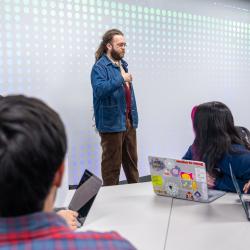Game Changer
Take a company from zero to $2 billion in 20 months, and don’t be shocked when your friends, family and investors want to celebrate with you.
Brendan Iribe’s surprise bash, held just days after Facebook acquired Oculus VR, the business he co-founded and leads as CEO, looked like something straight out of “This Is Your Life.”
Guests who’d secretly flown to Southern California included the elementary-school buddies he played video games with. The college roommates he entertained with visions of his first business. The computer programming wizards he recruited over the past 15 years. His mother, Elizabeth, who supported him in every venture and helped organize the celebration.
Back on the East Coast were other happy investors, like the tech company guy who gave him his first programming job at age 15 and the uncle who pitched in with seed funding and accounting at the video-game software firm Iribe and two friends started at the University of Maryland.
Iribe had convinced people from every stage of his 35 years to support Oculus VR. Now, many of them stood beside him to toast the company’s success and future. Oculus was this much closer to developing a totally immersive 3-D virtual reality (VR) experience, one that has the potential to transform entertainment and social communication.
“After a while it was a no-brainer. I’ve invested in every company he’s ever created,” says Ernie Falcone, B.S. ’86, electrical engineering, who employed Iribe in high school and college. “Brendan is a decent programmer. He’s an incredible visionary.”
Iribe rose to success through uncanny instinct, intelligence, unwavering confidence and shrewd business sense, along with a fervent loyalty to the friends he cultivated along the way.
“Steve Jobs really hit it when he said the journey is the reward,” Iribe said in September, as he announced he was committing $31 million to UMD—the university’s largest single gift—to construct a new computer science building. “But I would add that the memories and the relationships are what last forever on that journey.”
On stage with him during the announcement stood the foremost example of his enduring friendships and his ability to identify the best people in the industry to execute his ideas. Iribe’s longtime business partner (and former Denton Hall floormate) Michael Antonov, B.S. ’03, computer science, now co-founder and chief software architect at Oculus, donated $4 million toward construction of the building and computer science scholarships.
Their first company, Scaleform, sold for $36 million. Their second, Gaikai, went for $380 million.
Now Oculus bears the title of the first Kickstarter-funded startup to become a multibillion-dollar company. VR experiences using the Oculus Rift goggles and software stole the show earlier this year at Comic-Con in San Francisco and South by Southwest in Austin. Blown-away bloggers and tech writers have proclaimed the Rift the next big thing in computing, and over 75,000 new developer kits have been sold. And everywhere, there is Iribe, the who-needs-sleep? leader, the device’s greatest evangelist.
“It’s hard to understate the impact VR is going to have,” Iribe says. “We can replace what you see in the world with anything we want.”
BORN TO LEAD
Iribe had too much charisma to ever be a traditional tech geek.
He was raised by his mother, first in a 100-year-old farmhouse in western Virginia, then in Howard County, Md. There she married Alan Peters, a chemist who cultivated Iribe’s budding interest in computers and video games—Mario, the Legend of Zelda, Commander Keen and Doom.
In the early 1990s, Peters helped a preteen Iribe buy his first computer, an original IBM PC 086. While playing video games, Iribe realized that he could freeze his shoot-’em-up game to stare at the 1s and 0s in the memory. He started hunting for patterns and soon figured out how to modify the programming code to give himself unlimited lives and ammunition. Then he boosted his popularity at school by sharing a program with friends to run on their home computers.
“Everybody wanted it,” he recalls. “‘You’re still dying? Here’s my program to stop that.’”
At Atholton High School in Columbia, Md., computer science teacher and soccer coach Reg Hahne told the sophomore he didn’t make the team, but said Iribe was a better fit in his classroom.
“He was eclectic and intense,” says Hahne, who still keeps in touch with Iribe. “He always wanted to ask the next question: What if? What if? He was never satisfied. He always wanted to do better.”
By 15, Iribe landed his first job, working for Wayne Moore, founder of Department of Defense engineering subcontractor Microcosm. Iribe was one of several gifted and talented students in Howard County schools employed by Moore to develop new software and to build a video game for his new company, Alien Software.
“I didn’t know what I was doing,” Moore says. “Brendan shouldn’t have known what he was doing. But he knew immediately how to organize these guys. He figured out you should be doing this, and you shouldn’t be doing that. He totally reframed the entire effort.”
Moore shut down the effort, though, when he couldn’t get a production company to put the game on the market, which was just being taken over by 3-D gaming.
Until then, Iribe says, “We had so much fun, eating pizza and subs every night while we worked late and played games. We were soaking up and learning. Wayne paid for this awesome education for me and nearly a dozen students.”
Iribe took that education to his second high-school job with a museum-exhibit designing firm in Laurel, Md., called Quatrefoil. At age 16, he was a lead programmer, cranking out multimedia programs.
“What we needed him to do, he was well suited for,” says Falcone, who founded the company with his wife, Abbie Chessler. “It wasn’t the artist part—it was the creative part of developing engaging exhibits and getting people jazzed. That’s what he’s still doing. He just got better and better at it.”
THE BOLD AND THE BRAINY
What changed everything for Iribe was meeting Antonov, a Steve Wozniak to his Steve Jobs.
They roomed across the hall from each other when they arrived at Maryland, and never did two students seem so different. Antonov, a Russian immigrant who grew up in Owings Mills, Md., was shy and bookish. He had started programming on a calculator, then in high school created games for his home PC.
Still, he and Iribe hit it off, and Antonov suggested they create a game together. Iribe was still working full time at Quatrefoil (and accumulating more than 200 campus parking tickets as he zipped back and forth—Falcone promised to pay them if it meant Iribe could stay at the office longer). Iribe jokes now that he “squeezed in” classes between all the time he spent working and gaming with friends.
Iribe decided to take off the following year to focus on Quatrefoil’s project building the music lab for the Experience Music Project Museum in Seattle. He didn’t quite leave the university, though.
One day in fall 1998, he drove by Antonov walking along Route 1, pulled over and offered him a ride home. Back in Antonov’s dorm room, Antonov showed Iribe an operating system he made in high school and the games he recreated using it. Iribe was stunned by their sophistication.
“Where did you learn to make all these games?” Iribe asked.
Antonov said he taught himself by reading programming books. He pointed to a stack of black and white composition notebooks. Inside them, in the tiniest print, he’d copied hundreds of pages of programming instruction from library books.
“You’re a genius and you’re crazy,” said Iribe, who immediately recognized a bigger opportunity to start a company with Antonov.
Their idea was to produce a new computer multimedia windowing system with richer graphics and gaming hooks than Microsoft’s. Sven Dixon, who had worked with Iribe at Alien Software as a digital artist, joined the team, along with Antonov’s roommate and a fellow programming whiz, Andrew Reisse, B.S. ’01, computer science, to launch their startup, Sonic Fusion, which was later renamed Scaleform.
“We were in a little bit over our heads,” Iribe says now.
GROWING PAINS AND GAINS
What may seem like an overnight success story really took years. Iribe convinced Antonov to take a break from school to get Sonic Fusion off the ground. (Antonov’s parents balked at that move, though, and he soon returned to Maryland part time.)
Reisse took a break from the programming workload when he couldn’t afford to work without a paycheck, and a broke Iribe and Antonov moved into Iribe’s mother’s house shortly after Iribe’s stepfather passed away.
Falcone, who had started another business called Mars Labs, and Iribe buckled down together to find investors for their companies among their friends, families and strangers.
“We never read books on raising venture capital,” Falcone says. “We just did it.”
Iribe’s mom and uncle pumped in additional funding as he and Antonov headed out to their Laurel office by 9 a.m. and returned after midnight, day after day, for four years.
Then they got the idea to drive out to California to convince some of their programming idols to support Scaleform. That met with only limited success, and they worked nonstop in a nearly empty apartment for months before returning to Iribe’s mom’s house.
Finally, they licensed their technology to Firaxis in Hunt Valley, Md., for a game called Civilization IV. It went on to be named 2005 Game of the Year by several gaming websites.
“Five years of our lives we slaved on this thing,” Iribe says. But he and Antonov realized their work couldn’t be scaled—it required too much technical support to tackle customers’ problems. They decided to drop it entirely, and start over. “That was a really hard decision to make,” Iribe recalls.
Yet another idea emerged from all of his networking: a slick, compact, high-speed, graphically beautiful interface system that would integrate easily into game engines and allow developers to use the Adobe Flash authoring tool. “Somehow I convinced Sven and Mike to stay with me and keep cranking to make this whole new product. I thank them all the time for not bailing, because at the end of the day, Sven created all the graphics and Mike wrote all the code. I just went out there to try to sell it,” Iribe explains.
Scaleform opened an office in Greenbelt, Md., where it remains today, and grew its staff to about 30 people. Their first product, GFx, got licensed throughout the industry and was featured over the next few years in hundreds of PC, Wii, PlayStation 3 and Xbox 360 games, including Crysis, Mass Effect and Gears of War 3.
In February 2011, after more than a decade of relentless work, Autodesk acquired Scaleform, and Iribe began looking for a new opportunity. Nate Mitchell, who was first hired by Iribe as a Scaleform intern and is now vice president of product at Oculus, says Iribe’s exit was a blow, temporarily: “The energy left the building so fast you wouldn’t believe it. He really did serve as an Energizer Bunny, powering the speed and momentum of the company.”
Iribe landed at a cloud gaming company in Southern California called Gaikai, and Antonov, Reisse and Mitchell soon followed. Their goal: to make gaming consoles obsolete by allowing gamers to rely on the cloud to stream to smart TVs. Sony, which was working on a cloud platform for PlayStation 4, bought the company within a year.
“We were starting to get the hang of this,” Iribe says jokingly.
THIRD TIME, ANOTHER CHARM
With Oculus, Iribe again revved up a life already in overdrive.
A friend offered to introduce him to Palmer Luckey, who as a home-schooled teenager had cobbled together a VR headset called the Oculus Rift, made of cellphone parts and a goggle-like frame. Luckey predicted that it would someday offer true immersion—the holy grail of gaming.
As the now-legendary story goes, word reached John Carmack, creator of the Doom and Quake franchises who is widely considered the father of 3-D, first-person-shooter games. Carmack contacted Luckey, asking to show the Rift to a few people at E3, the premier video gaming conference.
Luckey sent him one of only two prototypes. (He later told Iribe: “It’s like Jesus asking to borrow your clothes. You just give them.”) And those “few people” turned out to be nearly a dozen reporters.
Carmack declared it not just “fundamentally cool,” but “the best VR demo for this kind of thing ever made.” He expressed confidence that several major improvements could be made quickly and that the Rift headset would be available to consumers in the near future.
The Rift was a sensation and was awash in a tidal wave of positive press in June 2012 when Iribe agreed to take a closer look.
Yes, the duct-taped device was clunky and had serious problems, such as blurriness, a too-narrow field of vision, multiple cords to get tangled around and time lag that—like every other attempt at VR—made Iribe nauseous within seconds. But he saw potential.
“Mike, Nate, Andrew and I put our heads together and thought about what this could really become and where this could really go,” he says. “We got incredibly excited about it.”
The foursome agreed to form Oculus VR with Luckey and launched a $250,000 Kickstarter campaign to fund the mind-boggling amount of R&D required to improve the Rift. They produced a video over the next two weeks featuring testimonials from some of the biggest names in the gaming industry. The crowdfunding effort raised $800,000 in the first 24 hours, ultimately netting over $2.4 million in 30 days.
Carmack quit his job as co-founder of id Software to become chief technology officer at Oculus. The company raised over $90 million in venture capital and, with the help of Valve Software in Washington state, made huge strides improving the Rift, including the ultra-low latency 360-degree positional tracking and rendering needed to avoid disorientation. Users looking right and left and tilting their heads up and down get the sense of “presence”—of being in another world. “Working closely with Valve, we finally cracked the code and proved we could deliver a comfortable experience that everyone enjoyed, even the most sensitive users like me,” says Iribe.
Other possibilities for the technology beyond gaming quickly became apparent: teach children about the solar system, help medical students learn how to perform surgery, take homebound (or cash-poor) users on virtual vacations and even put fans in the middle of sporting events.
The Rift won every best-of-show or best product award at major trade shows and wowed attendees at South by Southwest Interactive this past March, where fans lined up for hours to step into a “Game of Thrones” simulation in which they could reach the top of “The Wall” up a rumbling elevator and stand amid whipping winds. Their mouths hung open in amazement—what Iribe calls “the Oculus face.”
It wasn’t long before Facebook founder and CEO Mark Zuckerberg visited Oculus to test the latest prototype himself. He and the Oculus leadership talked about the difficulty of eliminating motion sickness and the hardware engineering still needed: custom optics, screens, sensors and cameras. Building and manufacturing a consumer-ready platform was going to cost hundreds of millions of dollars. Speaking with Zuckerberg, Iribe laid out his vision: “Oculus is going to revolutionize not just gaming and entertainment, but the way humans interact. You’ll truly believe you’re in a new virtual environment and you won’t be alone. Virtual reality is the only platform that can connect everyone face-to-face. Imagine the whole world is in a pair of glasses.”
An impressed Zuckerberg acknowledged that Oculus had gaming figured out and Facebook knew social networking and communication. Together, they could connect a billion people in virtual reality.
Within three days, they’d hammered out the essentials of a deal for Facebook to acquire Oculus. The deal allowed the startup to keep working autonomously, but with vastly more financial support.
“Oculus has the chance to create the most social platform ever, and change the way we work, play and communicate,” Zuckerberg said in the official announcement.
It was news around the globe. Iribe and Co. were the darlings of the tech world—and 10 days later, he and Antonov were headed back to the University of Maryland.
CREATING THE FUTURE
Iribe and Antonov had reconnected with the university only a year earlier under the most heartbreaking of circumstances. Reisse, an Oculus co-founder and lead engineer, and an avid hiker and photographer, was killed in a hit-and-run accident near his Santa Ana, Calif., home in May 2013.
Iribe, Antonov and their co-workers, along with Reisse’s parents, Robert, M.S. ’70 and Ph.D. ’76, physics, and Dana, M.L.S. ’73, library and information services, quickly funded a new scholarship for Terp computer science students in his name.
“We wanted Andrew to be remembered and to support the kind of independence, creativity in computer science and the love of nature, which he had,” Antonov says.
He and Iribe were invited back to Maryland for Bitcamp, an April 2014 event that drew 700 students nationwide to hack together websites, apps and computer hardware projects.
Computer Science Department Chair Samir Khuller worried that amid the Oculus news frenzy, the pair would back out. Instead, they spoke to a standing-room-only crowd, donated more than 40 Rifts to the deliriously happy student hackers and toured their old stomping grounds in the A.V. Williams building.
Passing the computer science classrooms and research labs carved out of the building, which opened in 1987 as office space, Iribe recalls, “My first thought was, this is pretty depressing. How can people get inspired to create the future in a space like this?”
Someone mentioned that computer science needed a new home. “It just hit me and I said, ‘We can help. How much is a building?’” Iribe remembers.
In August, Iribe signed the paperwork to give the University of Maryland $30 million to fund the Brendan Iribe Center for Computer Science and Innovation, and another $1 million for scholarships. Antonov followed suit, pledging $3.5 million for the building and $500,000 for scholarships. Elizabeth Iribe, her son’s most loyal investor, gave $3 million to endow two professorships in computer science.
Iribe likes the ideas of “giving while living,” as well as encouraging students to create and researchers to explore the potential of virtual reality, while making the University of Maryland a national model in this field.
“It’s fun to do this project when virtual reality is about to take off, and the center is going to be there right from the beginning,” Iribe says. “There’s going to be an environment at Maryland that fosters creativity and innovation in computer vision, robotics, virtual reality and everything that is impactful in computer science.”
In the meantime, he’s still pushing to get the Rift to the market—he deflects the near-daily question of “When?” Oculus has grown to more than 200 employees at offices in Seattle, Dallas, and Menlo Park and Irvine, Calif., and is advertising 60 new positions.
“There’s a constant drive to do better. It’s great for the product and great for the team,” Mitchell says. “He jokes that I’m Nice Nate and he’s Bad Brendan. Say there’s a product that comes before us. I’d say these five things aren’t important. He’d disagree and say all five have to be done.”
Members of the crew work long days and nights (often in flip-flops or stocking feet).
Falcone laughs as he recalls their diet for staying up all night at Quatrefoil: “A scoop of vanilla ice cream, grind the s*** out of some coffee, pour it on top and eat it, while pounding Cokes and Dr. Peppers all the time.”
When Iribe left Quatrefoil all those years ago, he posted a note on Falcone’s wall, where it remains today: After four years and many sleepless nights, Brendan’s saga ends. Not really. It’s hard to get rid of me.
Writer: Lauren Brown
See also:







